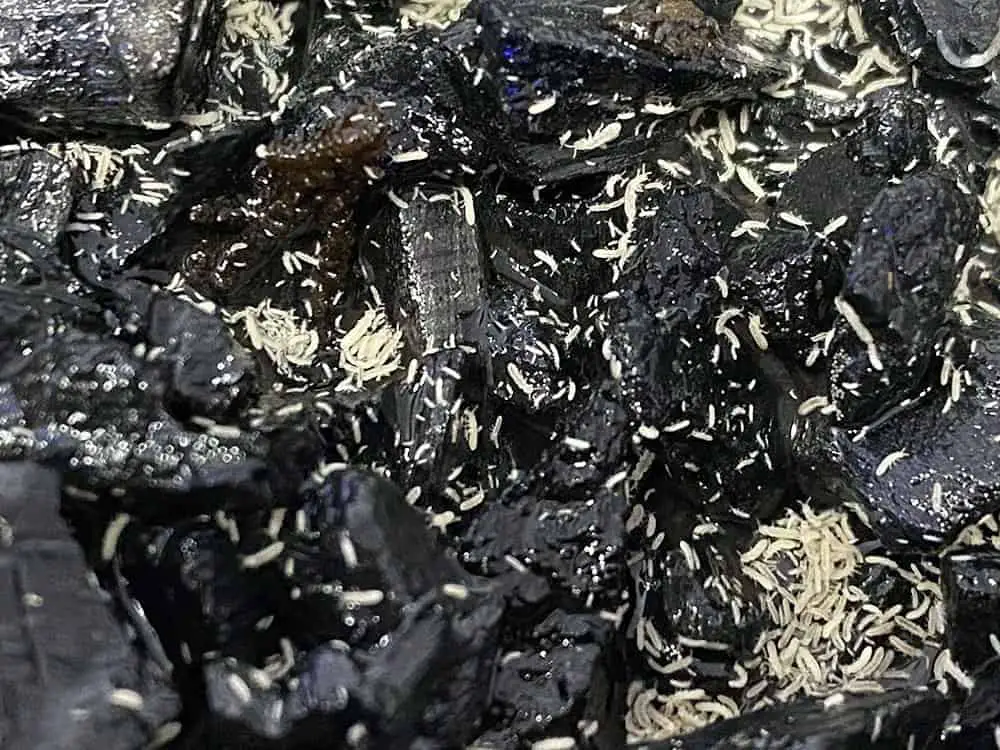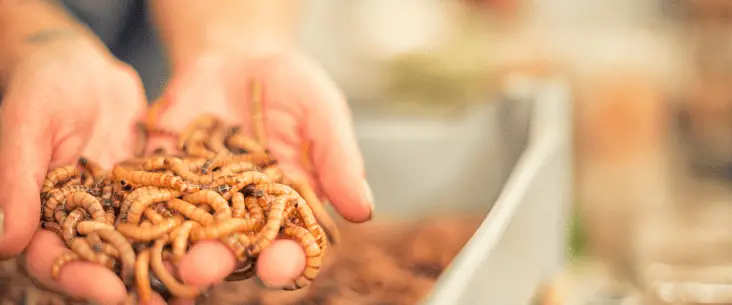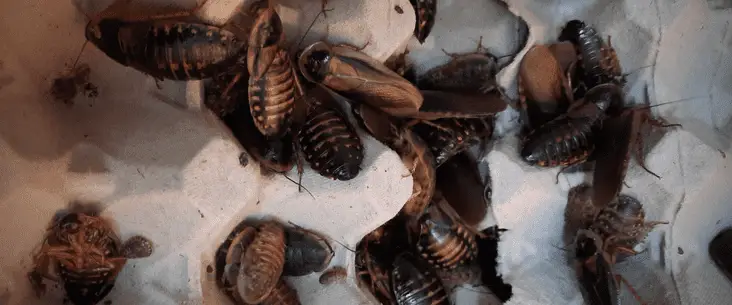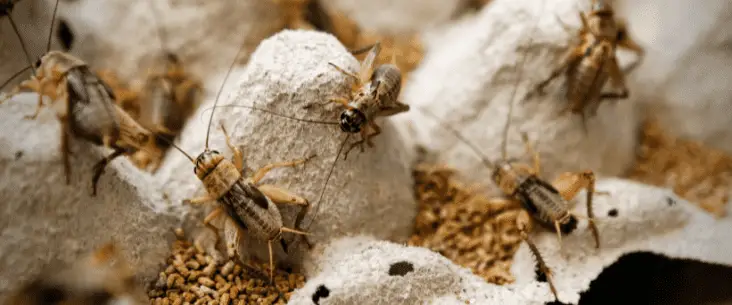White springtails (Collembola sp.) are useful insects and a great addition to a nutritious diet for small frogs, fish, small geckos and other small insectivores. Alongside being a proper food source, springtails are also very useful as a clean-up crew and can be the janitors of your terrarium, vivarium or paludarium. Springtails are detritivores which means they only feed on dead organic material, fungi and bacteria. They help clean up your enclosure tank, will keep moulds down and prevent the fungus from spreading. After knowing this breeding method, you never rebuy springtails, and still have this precious insect always available from your own culture for many years.
After I first used the breeding method of culturing springtails on charcoal with water, I never had to repurchase springtails. It is so simple: you only need charcoal, water, food and of course the springtails. They breed easy and fast; you never run out of springtails again.

Setting up a breeding culture in 3 easy steps
Although there are more ways to culture and breed springtails to use as feeder insects or to make bioactive setups for your tank, this particular method is both easy, cheap and fast. You have your own springtail culture up within 3 easy steps.
Step 1 — Find a suitable container
First, you need to find a suitable sized container. Sterilite containers, deli cups and plastic jars with screw lids are all suitable for breeding springtails. I prefer Sterilite containers or low large base deli cups of at least a size of 6 litres (~6 Quarts).
Important is that the container has a lid included and that the lid closes tightly; otherwise, the springtails would escape from their container.
Step 2 — Fill up half the container with charcoal and add water
The next step is to include the medium to breed the springtails on. We use charcoal for this purpose. You can also use potting soil, coconut fibre or peat moss; however, with these mediums, it is more difficult to harvest your springtails. Especially if you want to transfer them to a second breeding container, you have to dig them out. With charcoal, it is much easier to transfer springtails.
Several types of charcoal can be used as a breeding medium for springtails:
- Lump wood charcoal — In my opinion the best one to choose. It is easy and cheap to buy, and you can get large quantities of it. Yes, it is the charcoal you can find in the BBQ section at your local supermarket. Sometimes it contains large lumps and in that case you need to make it in smaller pieces.
- Horticultural charcoal — This type of charcoal works very well, and this charcoal is of high quality, but you also pay the premium price for it. So it’s up to you!
- Activated charcoal — Also called activated carbon. This type works well but has pretty small pieces. Although there is nothing wrong with it, because of its price and any more perks than simple lump wood charcoal, I’m not a fan of it.
- Bonfire charcoal — You can use the charcoal of a bonfire as well. However, you need to clean the charcoal and rinse it with water, and the fire must be started without the use of a catalyst (like lightning fluid). And be aware that from a bonfire, you don’t get many good pieces of charcoal, so don’t expect much of it.
- Never use charcoal briquets — Never use charcoal briquets. These pieces are not suitable for breeding springtails.
Fill up half of the container with the selected charcoal. After that add about 1cm to 2.5cm (½”-1″) of water to it. The water needs to be chlorine-free, so if you doubt your tap water use demineralized water or water from a bottle instead.
Step 3 — Place springtails in this setup and wait
Now it is time to add the springtails to it. If you have to order your first springtails choose the temperature white springtails. You can order them on charcoal or a mixed substrate. Some have experienced more springtail death when shipping a charcoal culture. On the other hand, charcoal makes it easier to transfer them into your breeding setup (and you only have to order them once if all goes well).
This springtail culture can be dumped into your setup, or filled with water, so the springtails float and you can pour them into your setup.
If you have bought a springtail culture from a mixed media substrate, you can use a piece of charcoal or tree fern to transfer the springtails into the new breeding setup. Moisten the piece of charcoal or tree fern and sprinkle it with yeast powder. The next day this piece will be full of springtails, and you can shake them off into your new setup. Repeat the process until you have most springtails transferred.
Try to add at least 50 springtails into your breeding setup (or at every setup if you have more). However, when added more springtails will make your culture more quickly ready to harvest.
Now it is time to care for them and wait for them to breed.
How to care for springtails
Caring for springtails is very easy and only costs you around two minutes a week. You only have to worry about two things: feeding them and keeping the container moist.
There are two types of feed that work very well. Many keepers use uncooked rice. Rice will last a few weeks (although depending on the size of your culture) and is pretty cheap that will last long. Mould will quickly grow on the pieces of rice, but that is just fine because springtails will feast on mould.
Another product that works well is nutritious yeast which is loved by springtails. Some sellers repackaged it as “Springtail Food”, but it is still the same product. However, yeast doesn’t last that long so don’t buy too much of it in one go.
How much you need to feed really depends on the size of your culture and don’t feed when there is still food left in the container. It is important to open at least two to three times a week the container to add fresh oxygen and to prevent carbon dioxide buildup. Also mist your container once in a while to keep it moist, or replenish the layer of water on the bottom. Be sure you use dechlorinated water for this. Keeping your culture at room temperature between 18°C and 26°C (65°F-80°F) makes them thrive and reproduce best.
New cultures will be ready to use within two to four weeks. Established cultures can use weekly or every other week, depending on the production rate of your breeding culture. If you take good care of your springtail culture, it can last for many years without having to replace the medium or rebuy new springtails.

Harvesting from a springtail culture: 4 easy methods
But when you have bred enough springtails, there comes a time you also need to harvest them from your breeding culture. Harvesting is done for mainly three reasons:
- To use for animals that feed on them.
- To make a bioactive setup in your enclosure.
- To seed a second culture to breed with them for the above two reasons.
It is good practice to have at least two cultures at all times. This way, you can use one as a base culture and the other to use for feeding (or another purpose), or you can alternate between the two cultures. By doing this, you always have a “back-up” population of springtails that will breed in the meantime. Also, always try to leave some springtails in the container, so it is always easy to breed with them again.
Harvesting springtails (getting springtails out of the container) can be done with four methods. Which method you should use is up to you.
Method #1 — Water pouring
The first method is called water pouring and is one of the simplest methods. You will fill up your springtail container with more water so the springtails will start floating on the water surface. Then you start pouring the water, and the springtails will float out of your container. This method is handy for seeding a second culture or adding springtails to the enclosure.
Method #2 — Tipping
With the next method, we just tip the container slightly and tap mildly to the container to let the springtails fall out/jump out of the container. This method is mostly used for adding springtails to an enclosure to create a bioactive setup or for feeding animals like frogs — you sort of sprinkling them throughout the enclosure. This method doesn’t work to seed for another culture because many springtails will jump out and escape from the container.
Method #3 — Sucking up
Another method is to use a turkey baster or similar tool to suck up water that contains springtails so that you can spray them onto another object. This method is useful for feeding particular animals by spot spraying the springtails into the enclosure. You can also use it to seed a second culture. It can be that there stay some springtails behind in the baster, so suck up pure water a second time to clean out any springtails left behind.
Method #4 — Dump or placing
The last method is just dumping or placing the whole breeding culture, including the charcoal, into another container or enclosure. This method is used when you use a small culture to place them into a larger container or when setting up a new terrarium or vivarium, where the charcoal, including springtails, are embedded in the substrate. Sometimes, we also place a whole container with springtails inside an enclosure so that animals can eat from the animals for several days.

Some other quick tips!
- The initial investment is around $20 to $40, and the initial setup can provide springtails for many and many years (probably a never-ending supply).
- It seems like nutritious yeast minimizes the risk of attracting and introducing detritivorous mites into your springtail culture.
- Never let your springtail culture dry out. Always keep a layer of water in the container and spray once in a while to keep the charcoal moist. Springtails stop reproducing when it is too dry, and it will eventually destroy your springtail culture.
- Freshly started springtail cultures are not sustainable and when immediately used as a feeder source makes them useless for breeding again. When you want to use a springtail culture to feed your animals multiple times, you need to wait at least a month.
- And when using a springtail culture to feed animals, never deplete the container, so your culture can reproduce and replenish itself.
- Keep them at normal ambient daylight, but never place a container in direct sunlight. Direct sunlight definitely causes overheating and kills your whole culture quite quickly.
- I have the best experience with temperate or tropical springtails. Of course, you can use many other springtail species, but this guide focuses on the use of these two species.
Other insects you can easily breed at home!
Besides springtails, there are several other feeder insects that you can easily breed at home so you don’t have to buy them again. Check out the breeding guides for the following feeder insects:
– Crickets
– Locusts
– Dubia roaches
– Superworms
– Fruit flies
Share this page!



